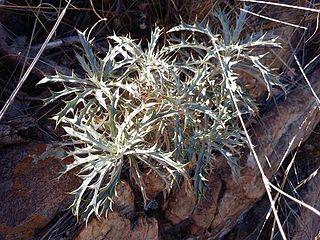
Adonis is a genus of about 20–30 species of flowering plants of the crowfoot family, Ranunculaceae, native to Europe and Asia.

Pachypodium ambongense is a species of plant in the family Apocynaceae. It was first published as a species of the genus Pachypodium in 1924 by the botanist Henri Louis Poisson.
Paphinia dunstervillei is an orchid species native to Venezuela.
Bulbophyllum tokioi is a species of plant in the family Orchidaceae. It is endemic to Taiwan. It was described in 1935 by Noriaki Fukuyama.
Epidendrum polystachyumHBK (1816) is an epiphytic orchid, which grows wild in seasonally dry forests on the western slopes of the Andes in Ecuador and Peru at altitudes near 2 km.
Bulbophyllum cogniauxianum is a species of orchid in the genus Bulbophyllum found in Brazil.

Bulbophyllum cruciatum is a species of orchid in the genus Bulbophyllum found in Papua, Papua New Guinea, Seram Island, and Maluku Islands.

Bulbophyllum rosemarianum is a species of orchid in the genus Bulbophyllum.

Epidendrum sophronitisLinden & Rchb.f. (1857) is a small Epidendrum orchid that bears a superficial resemblance to a Sophronitis, as the generic epithet was used prior to the year 2000.

Leucas aspera is a plant species within the genus Leucas and the family Lamiaceae. Although the species has many different common names depending on the region in which it is located, it is most commonly known as Thumbai or Thumba. Found throughout India, it is known for its various uses in the fields of medicine and agriculture.

Aganosma cymosa is a liana that can grow up to 10 m (33 ft) in length, pale brownish tomentose. Leaf-stalks are 1–2 cm (0.4–0.8 in), leaf blade broadly ovate or orbicular, 5–16 cm (2.0–6.3 in) by 4–12 cm (1.6–4.7 in), base rounded or obtuse, apex acuminate or obtuse, rarely retuse, lateral veins eight to ten pairs. Flowers are borne in many-flowered clusters at branch ends, which are carried on stalks up to 6 cm (2.4 in). Bracts and bracteoles are very narrowly elliptic, about 1 cm (0.4 in) long. Flower-stalks are about 5 mm (0.2 in). Calyx with several glands inside margin of sepals; sepals very narrowly elliptic, about 1 cm (0.4 in), pubescent on both surfaces. Flowers are white, minutely tomentose outside, glabrous at throat; tube shorter than sepals, 6–7 mm (0.2–0.3 in); lobes oblong, as long as tube. Disc longer than ovary. Ovary pubescent at apex. Follicles 2, cylindric, to 30 cm (12 in) by 0.8–1.2 cm (0.3–0.5 in), yellow hirsute. Seeds oblong, 1–2 cm (0.4–0.8 in) by about 5 mm (0.2 in), coma 2–4.5 cm (0.8–1.8 in). It is native to China, Bangladesh, India, Sri Lanka, and Indochina.
Trompettia cardenasiana is a species of nightshade that is a spiny shrub bearing very small leaves, 0.35–0.5 cm (0.1–0.2 in) by 0.1–0.12 cm (0.04–0.05 in), a yellow trumpet-shaped campanulate flower, measuring about 3 cm (1.2 in) long and globose fruit. The growth habit is somewhat reminiscent of certain Lycium species. It is endemic to Bolivia, growing in dry, Andean valleys at altitudes of 2,000–2,500 m (6,600–8,200 ft) and 3,000–3,500 m (9,800–11,500 ft) and has been collected near the town of Cotagaita in Potosí Department.

Digitaria insularis is a species of grass commonly known as sourgrass. It is native to Central and South America and the southern parts of the United States and has been introduced into other parts of the world. It was first described by the German botanist Friedrich Karl Georg Fedde in 1904.

Pearsonia cajanifolia is a South African shrublet belonging to the family of Fabaceae, and one of 13 species in the genus, usually herbs or shrublets with woody rootstocks and all occurring in Africa south of the equator with the exception of 1 species found on Madagascar. P. cajanifolia is commonly found in submontane grassland, at altitudes 1350–2100 m, in the South African provinces of Free State, Gauteng, Limpopo, Mpumalanga, and North West, also in Zimbabwe and Malawi.

Berkheya carlinopsis Welw. ex O.Hoffm. is a Southern African herb or subshrub belonging to the family Asteraceae and was first described in 1896 in Boletim da Sociedade Broteriana 13 34.
A perennial herb or subshrub up to c. 1.5 m. tall. Stems branched, whitish araneose-tomentose, or glabrescent, leafy. Leaves sessile, 3–6 cm. long, dentate to pinnatifid-dentate; lamina 2–3(4) mm. wide and linear or 5–15 mm. wide and lanceolate; teeth 3–8 on each side, each tooth 2–6(10) mm. long, triangular or linear and extended in a tawny spine 2–3 mm. long; margins of teeth and sinuses entire or armed with smaller spines; upper surface smooth or somewhat scabrous, slightly to densely araneose-tomentose or glabrescent; lower surface whitish felted-tomentose. Capitula radiate, solitary and terminal on the branches, or subcorymbosely arranged, 2.5–5(+?) cm. in diam. including the rays. Phyllaries spreading, felted-tomentose outside, subglabrous or glabrous inside, 10–20 x 1–3 mm., linear-lanceolate, spiny-acuminate, ciliate-spinescent on the margins with spines 1–3 mm. long; the outermost phyllaries ± leaf-like with small spine-tipped teeth; inner phyllaries smaller and less spinescent-ciliate. Margins of the receptacular alveolae extended into straw-coloured bristles 1–2 mm. long. Achenes 1.5–3.5 mm. long, turbinate, 8–10-ribbed, strigose-sericeous, glandular-viscid at the apex. Pappus scales 2-seriate, 1–1.5 mm. long, narrowly oblong, acute or subobtuse, denticulate towards the apex.

Passiflora bogotensis is a climbing plant native to Colombia, in the genus Passiflora. It can also be found in Venezuela.

Lepanthes kokonuko is a species of orchid from southern Colombia. L. kokonuko can be easily recognized by its caespitose medium-sized plants, elliptical coriaceous leaves, long loosely, flexuous and distichous inflorescences; strongly revolute lateral sepals, transversely bilobed petals with the upper lobe lanceolate (hornlike), and a bilaminate lip with the blades ovoid–lanceolate with a bipartite appendix.

Bulbophyllum sect. Hyalosema is a section of the genus Bulbophyllum.
Bulbophyllum amorosoanum is a species of orchid in the genus Bulbophyllum found in Bukidnon, Mindanao, Philippines.

Helianthemum almeriense, also known as jarilla, mata turmera or tormera in Spanish, is a very branched woody plant of the Cistaceae family, with showy white flowers, which blooms in winter and spring.













